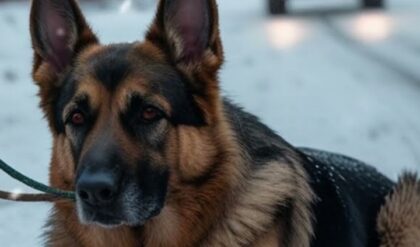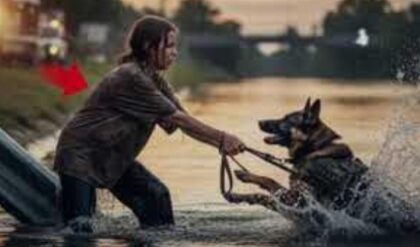
By William F. Floyd, Jr.
On July 28, 1943, Luftwaffe Oberleutnant Erwin Clausen shot down another two B-17 Flying Fortresses to add to the two he had shot down the previous day. There were 15 other Focke-Wulf FW-190 pilots that claimed downing a bomber in defense of the aircraft works at Kassel and Oschersleben. It is believed that this was the first time that the Luftwaffe’s single-engined fighters had been able to employ under-wing rockets against the American bombers.
The following day, as 15 groups of B-17s attacked targets on the Baltic coast, it was the weather that provided the best cover for the bombers. The Luftwaffe response was relatively weak with only four Jagdgruppen FW-190s sent up to oppose the bomber force. The Focke-Wulf group was credited with four of the 12 claimed to have been shot down, which agreed with what the Americans stated they had lost.
The next day the B-17s were headed for a second strike against the aircraft factories in Kassel. On this occasion, the Luftwaffe reacted stronger than before. Among the planes sent up, there were at least five Focke-Wulf FW-190 units. The Focke-Wulfs of Jagdgeschwader 1 did not engage the bombers until after they had left the target area and were about to recross into Dutch territory. At that point, they would be under the protection of Allied fighters that would escort them back to the United Kingdom. Despite this development, the pilots of JG1 were able to claim six B-17s and two enemy fighters destroyed. The successes came at a high price: the loss of seven aircraft. Among the pilots killed were two Staffelkapitane and the campaign’s then-leading FW-190 four-engine bomber ace, Oberfeldwebel Hans Laun of 1.JG 1, who was shot down near Arnhem, Netherlands.
The Focke-Wulf FW-190 was widely believed to be the best fighter aircraft of World War II. As the war went on the FW-190 was manufactured in no fewer than 40 different models. The appearance of the new aircraft over France in 1941 was a rude surprise to the Allied air forces. The FW-190 was in service for the entire war, replacing a number of other aircraft including the Junkers Ju-87 Stuka dive bomber. Possibly the plane’s biggest influence on the Allies was that it served to spur on greater advances in technology and aircraft design to counter the threat of the FW-190.
The Focke-Wulf FW-190 not only was a superb daytime fighter but was also used extensively as a night fighter, interceptor, and ground attack aircraft on the Eastern, Western, and Italian Fronts. The introduction of the FW-190 changed the capability of the Luftwaffe’s combat operations. This was especially the case with the introduction of the FW-190D in 1944. This new model offered superior handling with a top speed of more than 400 miles per hour.
During the first two years of World War II, the Messerschmitt Me-109 was the preeminent German fighter plane, there was simply nothing else. But in 1941, during cross-Channel aerial warfare between the Royal Air Force and the Luftwaffe, a new challenger entered the fight on the German side. The Me-109 from that point forward would have a new partner in the air war.
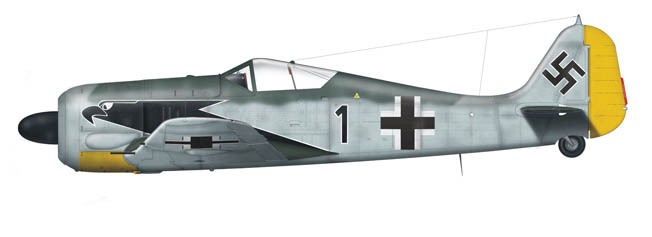 An Fw-190 flown by Luftwaffe fighter ace Oberleutnant Horst Hannig, who was credited with 98 aerial victories before dying in combat in 1943.
An Fw-190 flown by Luftwaffe fighter ace Oberleutnant Horst Hannig, who was credited with 98 aerial victories before dying in combat in 1943.
Design History of the Fw-190
The development of the FW-190 began with a contract in 1937 from the Reichsluftfahrtministerium for a new single-seat fighter. The new plane was designed by Focke-Wulf engineer Kurt Tank, a German aeronautical engineer and test pilot. He was chief engineer in Focke-Wulf’s design department from 1931 to 1945. He was not only responsible for the development of the FW-190, but also the Focke-Wulf Ta-152 fighter-interceptor and the FW-200 Condor. The FW-190 was first developed as two different models, one using the water-cooled inline Daimler-Benz DB 601 engine and the other using the BMW 139 aircooled radial. The BMW 139 was selected for development in summer of 1938. The first prototype flew on June 1, 1939. The BMW 139 produced 1,550 horsepower, attaining a speed of 370 miles per hour. As the prototype was refined, the BMW 139 was replaced by the BMW 801, which was heavier but had greater potential for future development. Although the engine did have some problems to overcome, the FW-190 showed excellent handling characteristics and its wide undercarriage made takeoffs and landings less hazardous. Powered by the new BMW engine, which produced 1,600 horsepower, the FW-190A-1 was armed with four wing-mounted 7.92mm MG17 machine guns.
First impressions of the new BMW 801 engine were not good. “The new twin row, 14 cylinder, air-cooled radial engine gave us nothing but misery. Whatever could possibly go wrong with it, did. We hardly dared to leave the immediate vicinity of the airfield with our six prototype machines,” reported one pilot. This criticism of the new plane is sometimes credited with saving the FW-190 project from cancellation. Eventually, the problems were sufficiently corrected for the plane to be cleared for service in July 1941. One of the major changes made by Tank and his designers was in the FW-190’s armament. They replaced the inboard MG17s with two 20mm FF cannons. The modified fighter now had the designation of FW-190 A-2 and took the Royal Air Force completely unawares with descriptions of the plane being discounted by British intelligence.
In June 1942, a fortuitous event occurred for the Allies. A Luftwaffe pilot accidentally presented an intact FW-190A fighter to his enemies. Oberleutnant Armin Faber landed on what he thought was a Luftwaffe airfield on the Cotentin Peninsula that turned out to be the RAF airfield at Pembrey, Wales. As he slowly taxied to a stop, Faber was intensely surprised when someone jumped on the wing and pointed a pistol at his head. The pilot was so despondent that he attempted suicide.
The RAF quickly took advantage of its windfall by transporting the aircraft to the Royal Aircraft Establishment at Farnborough. The airframe and engine were dismantled and thoroughly analyzed before being reassembled. After being test flown the plane was delivered to the Air Fighting Development Unit at Duxford, Cambridgeshire, where it was put through intensive performance trials and flown competitively against several Allied fighter types. The AFDU trials had proven what the RAF already knew, that the FW-190 was an outstanding development in fighter aircraft but was far from unbeatable.
The detailed examination of the FW-190 had a huge influence on fighter development in Britain. It resulted directly in the specification F.2/43 to which was designed the Hawker Fury, which incorporated numerous features directly copied from the FW-190A and F.19/43, which produced the Folland Fd.118 fighter project. There could be no higher praise than to have one’s enemies copy one of your designs. The FW-190A was one of the best models that could have come into the possession of the Allies. The FW-190A1 used the BMW 801C, 1600 horsepower engine, which powered a three-bladed variable pitch propeller that could attain a top speed of 388 miles per hour. The wide-track landing gear folded in toward the fuselage, which was extra strong to accommodate future weight growth and offered good stability on the ground. The FW-190A1 carried four rifle-caliber machine guns, two in the cowling and two in the wing roots, all of which were fired through the propeller arc. The event that resulted in the capture of the Focke-Wulf most likely contributed to saving the lives of countless RAF pilots.In 1943, the Luftwaffe was in need of a fighter with better high-altitude performance. The answer to this need was the long-nosed “D” model or “Dora.” The first production model was the FW-190 D-9 which attained production status in the early summer of 1944. The new plane’s purpose would be to face the Allied bombers, particularly the American Boeing B-29 Superfortress, which was known to be coming into service. The FW-190 D was the first production FW-190 to use a liquid-cooled engine and was a very good high-altitude interceptor equal to the North American P-51 Mustang or Supermarine Spitfire MK XIV without the altitude limitations of the FW-190 A. Deliveries of the FW-190D-9 began in August 1944. The first mission of the new fighter was to provide top cover for Messerschmitt Me-262 jet fighters during takeoff when they were most vulnerable. The prevailing opinion among the FW-190D-9 pilots was that it was the best Luftwaffe propeller-driven fighter of the entire war and was more than a match for the P-51 Mustang. The D Model was the stepping stone that led to the high-altitude Focke-Wulf Ta 152.
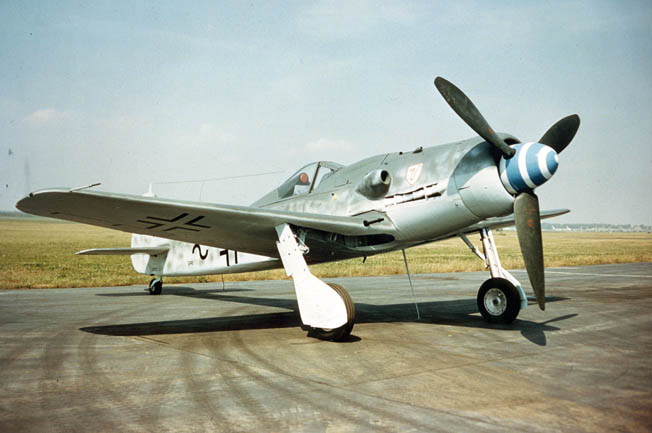 A captured Fw-190 displayed by the U.S. Air Force. When hostilities ended in Europe, the Luftwaffe had more than 1,600 FW-190s of which more than 800 were ground-attack variants.
A captured Fw-190 displayed by the U.S. Air Force. When hostilities ended in Europe, the Luftwaffe had more than 1,600 FW-190s of which more than 800 were ground-attack variants.
In honor of Tank, the FW-190’s designation was changed to Tank, or Ta-152. The inline engine fighter was going to be the top version of the now famous fighter, but delays prevented them being manufactured in adequate numbers. In the final chaotic year of the Third Reich only a few Ta-152Hs and possibly a few Ta-152Cs got into combat.
The Bomber Killer
The FW-190 first saw action over the English Channel in 1941. In February 1942, it was providing cover for the German battlecruisers Scharnhorst and Gneisinau and the heavy cruiser Prinz Eugen as they tried to reach northern German ports. In one engagement, the 190s destroyed all six attacking Royal Navy Fairey Swordfish torpedo bombers. The new fighter was a shock to the RAF, faster and more agile than the Spitfire. The FW-190 was a stout opponent in a dogfight with its extremely heavy armament. The FW-190 pilots tended to work in pairs, giving each other good tactical support in battle. The excellent visibility provided by the plane’s cockpit assisted the pilots in supporting one another. As time went on, the FW-190 became a terror to Allied aircraft in every region where the Luftwaffe was active. It inflicted huge losses on B-17 Flying Fortress and Consolidated B-24 Liberator bomber crews, and was almost impossible to stop until the long-range P-51 Mustang came into service in 1944 and began escorting bombers to their targets.
One of the more important roles played by the FW-190s was in the defense of the Reich, a strategic defensive aerial campaign. The Luftwaffe had set up a chain of fighter bases in northwestern Europe. These stretched from the Bay of Biscay to the Kattegat. By late summer 1942, the American Eighth Air Force was beginning to make its first forays into northern France. The first attack by the Eighth took place on January 27, 1943. Despite all the time, effort, and resources put in by both sides, the first fighting in the defense of the Reich was inconclusive. The FW-190s’ first attack was on several Liberators of the 44th Bomb Group. Two of the Liberators went down into the shallows between the Dutch coast and the offshore island of Terschelling. One source suggests that one of the bombers was lost as a result of a mid-air collision with a battle damaged FW-190, which tore off the B-24’s port wing and tail assembly. This action, like many of the claims made by pilots during the 27-month campaign, was never confirmed. If anything, this problem worsened as the number of aircraft involved in the never-ending air battles in the skies over Germany grew from dozens to the hundreds and eventually thousands.
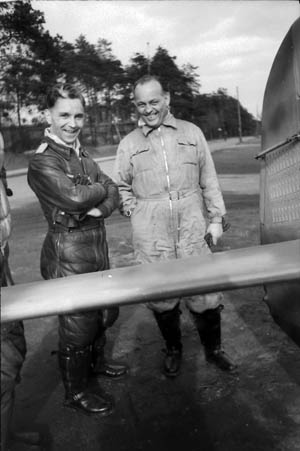 Fw-190 designer Kurt Tank with Luftwaffe pilots. Tank incorporated into his design two 20mm cannons capable of firing a high-explosive round.
Fw-190 designer Kurt Tank with Luftwaffe pilots. Tank incorporated into his design two 20mm cannons capable of firing a high-explosive round.
The first month of the air campaign ended with the raid on Wilhelmshaven on February 26, 1943. In this phase of the campaign, the fighting ended in
favor of the Luftwaffe, which downed 15 heavy bombers from the U.S. Eighth Air Force while it suffered seven pilots killed and one wounded. On March 4, the FW-190s played a major role in attacking a group of B-17s whose target was the marshaling yards at Hamm in North Rhine-Westphalia. Four of the five bombers were shot down in the Eighth Air Force’s first appearance over the Ruhr, Germany’s industrial heartland. On April 17, the Eighth Air Force returned to Bremen, but this time its target was the city’s Focke-Wulf aircraft factories. These were producing the very FW-190 fighters that the Americans were fighting in the air. During this raid the Americans lost 16 B-17s with 10 falling to the FW-190s. These losses were at least part of the reason that the Eighth Air Force did not reappear over the Reich for nearly a month. The attacks of June 25 brought to an end the first half of the fighting in the air campaign of 1943.
The opening rounds of the campaign had produced only mixed results. The overriding factor for this period was the absence of a fighter escort for the bomber formations. The final outcome was still far from certain. In the second half of 1943, the Eighth Air Force suffered catastrophic casualties, but the defenders’ losses would begin to escalate as the year wore on. In this period, the U.S. Army Air Forces lost 87 bombers and had more than 500 damaged mostly due to Luftwaffe attacks, many of which involved FW-190s.
The air campaign would soon become a different arena of battle entirely. The arrival of U.S. escort fighters in ever increasing numbers would dramatically change the situation. The Luftwaffe pilots would no longer have the luxury of remaining unmolested beyond the range of the bombers’ defensive fire and then deciding how to deliver the attack. Protected by their fighters, the bombers would be much more difficult to approach, and kills would become more difficult to achieve with losses inevitably becoming much higher.
The number of fighters escorting Eighth Air Force bombers was truly alarming to the Germans. The number would eventually exceed 500. One method which the Luftwaffe began to develop to counter the increased number of enemy fighters was to have the Me-109s keep the enemy fighters occupied while the FW-190s attacked the bombers. The Luftwaffe also transferred many of its most successful pilots closer to Germany to defend the Reich in the most critical campaign of the European air war.
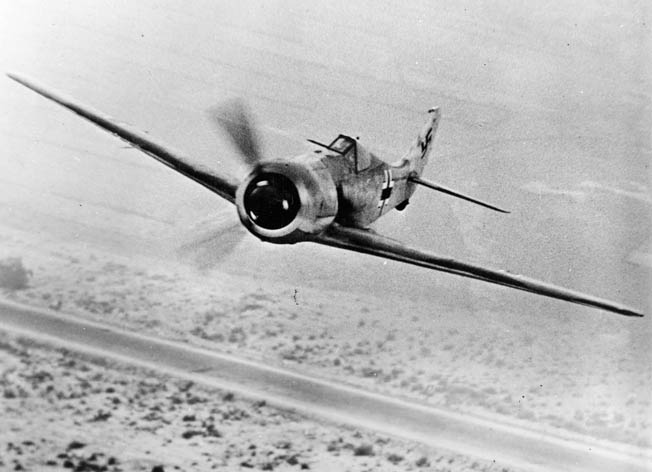 An Fw-190 over the desert in Libya. By the end of 1942, the Fw-190 was deployed with Luftwaffe forces in North Africa, Russia, and Western Europe.
An Fw-190 over the desert in Libya. By the end of 1942, the Fw-190 was deployed with Luftwaffe forces in North Africa, Russia, and Western Europe.
By the end of 1942, the FW-190 was fighting in North Africa, on the Eastern Front, and in Western Europe. In the Soviet Union, the FW-190 was effective in low-flying ground attacks on vehicle convoys and tanks. In this theater, the FW-190 carried 250- and 500-pound bombs, either of which could knock out a tank. One major issue on the Eastern Front was keeping the FW-190s and other aircraft supplied. This was at a time when many of the planes were flying up to eight sorties a day. On the Eastern Front, the FW-190’s reliable air-cooled engine and wide-track landing gear were well suited for service in the extremely harsh conditions. Operations on the Eastern Front led to a number of changes that resulted in the FW-190F fighter-bomber designed with a special emphasis on ground attack. This particular version carried 794 pounds of armor, which included sections of steel plate located behind the pilot’s head, on the lower engine cowling, and in the wheel well doors. The F-8 version turned out to be the most important model of the “F” series. Frontline units, using kits supplied by the factory, could adapt these aircraft to carry various combinations of heavy cannons, bombs, rockets, and even torpedoes.
As the war went on, the different models of the FW-190 were in almost constant contact with enemy bombers. This led to improvements in the form of more cannons and underwing rockets. Later, bomb racks were fitted to the FW-190 airframe under the fuselage and under the wings to broaden the capability of the fighter for attacking ground targets. By the end of the war, German fighter airfields were forced back closer to Berlin for fear of being bombed, which resulted in the FW-190 becoming more of a ground attack and support aircraft as German air power dwindled in the final days of the war. In spite of this situation, the beleaguered German air crews fought on with their FW-190s despite mounting losses. The Allied bombing campaign reduced the number of FW-190s, and the added issue of pilot attrition only made the situation for the Luftwaffe much worse. In the end, the FW-190 had played its role well in defeat as the war came to a close.
20,000 FW-190s Built
By the end of the war, more than 20,000 FW-190s had been built for the Luftwaffe. At peak production, 22 FW-190s were being produced daily. When hostilities ended in Europe, the Luftwaffe had more than 1,600 FW-190s, of which more than 800 were ground-attack variants. After the war, Tank, the primary developer of the FW-190, negotiated with the United Kingdom, the Nationalist government of China, and the Soviet Union for his services. However, negotiations with all three countries proved to be unsuccessful. He later accepted an offer from Argentina to work at its Aeronautical Institute under the pseudonym Dr. Pedro Matthies. Tank spent two decades designing aircraft abroad, including work in India, before returning to Germany in the late 1960s to work as a consultant for Messerschmitt-Bolkow-Blohm. The heavy demand for his services was a testament to his genius as an aircraft designer.
